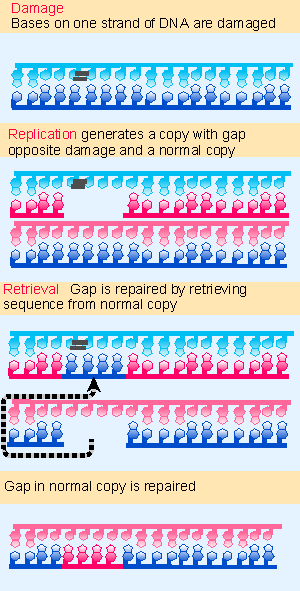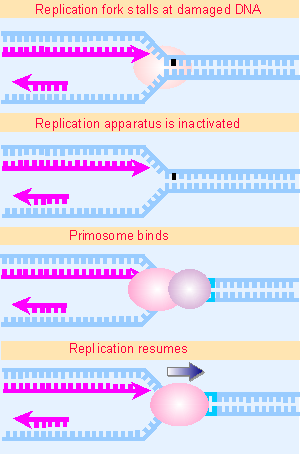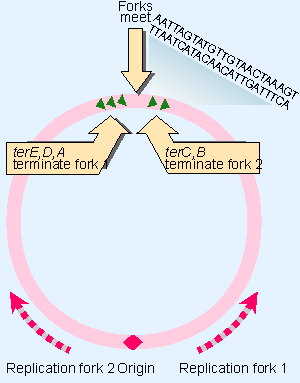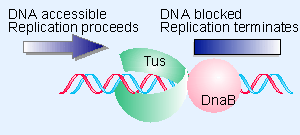9. The primosome is needed to restart replication
13.9 The primosome is needed to restart replication |
| Key terms defined in this section |
| Primosome describes the complex of proteins involved in the priming action that initiates replication on fX-type origins. It is also involved in restarting stalled replication forks. |
A more complex system is used for priming with the phage φX174 (with which in fact much of the early work was done). φX174 DNA is not by itself a substrate for the replication apparatus, because the naked DNA does not provide a suitable template. But once the single-stranded form has been coated with SSB, replication can proceed. A primosome assembles at a unique site on the single-stranded DNA, called the assembly site (pas). The pas is the equivalent of an origin for synthesis of the complementary strand of φX174. The primosome consists of six proteins: PriA, PriB, PriC, DnaT, DnaB, and DnaC. The key event in localizing the primosome is the ability of PriA to displace SSB from single-stranded DNA.
Although the primosome forms initially at the pas on φX174 DNA, primers are initiated at a variety of sites. PriA translocates along the DNA, displacing SSB, to reach additional sites at which priming occurs. As in oriC replicons, DnaB plays a key role in unwinding and priming in φX replicons. The role of of PriA is to load DnaB to form a replication fork.
It has always been puzzling that φX origins should use a compelx structure that is not required to replicate the bacterial chromosome. Why does the bacterium provide this complex?
 |
Figure 13.14 Replication is halted by a damaged base or nick in DNA. |
The answer is provided by the fate of stalled replication forks. Figure 13.14 compares an advancing replication fork with what happens when there is damage to a base in the DNA or a nick in one strand. In either case, DNA synthesis is halted, and the replication fork is either stalled or disrupted. It is not clear whether the components of the fork remain associated with the DNA or disassemble.
 |
Figure 14.35 An E. coli retrieval system uses a normal strand of DNA to replace the gap left in a newly synthesized strand opposite a site of unrepaired damage. |
 |
Figure 13.15 The primosome is required to restart a stalled replication fork after the DNA has been repaired. Animated figure |
The situation is rescued by a recombination event that excises and replaces the damage or provides a new duplex to replace the region containing the double-strand break (Seigneur et al., 1998; see Figure 14.35 in 14.16 Retrieval systems in E. coli). After this has happened, the replication fork must be restarted. Figure 13.15 shows that this may be accomplished by assembly of the primosome, which in effect reloads DnaB so that helicase action can continue (Kuzminov, 1995; Cox et al., 2000).
Replication fork reactivation is a common (and therefore important) reaction. It may be required in ~30% of chromosomal replication cycles. It is impeded by mutations in either the retrieval systems that replace the damaged DNA ofr in the components of the primosome.
Replication forks must stop and disassemble at the termination of replication. How is this accomplished?
 |
Figure 12.7 Replication termini in E. coli are located beyond the point at which the replication forks actually meet. |
Sequences that stop movement of replication forks have been identified in the form of the ter elements of the E. coli chromosome (see Figure 12.7) or equivalent sequences in some plasmids. The common feature of these elements is a 23 bp consensus sequence that provides the binding site for the product of the tus gene, a 36 kD protein that is necessary for termination. Tus binds to the consensus sequence, where it provides a contra-helicase activity and stops DnaB from unwinding DNA. The leading strand continues to be synthesized right up to the ter element, while the nearest lagging strand is initiated 50 V100 bp before reaching ter.
 |
Figure 13.16 Tus binds to ter asymmetrically and blocks replication in only one direction. |
The result of this inhibition is to halt movement of the replication fork and (presumably) to cause disassembly of the replication apparatus. Figure 13.16 reminds us that Tus stops the movement of a replication fork in only one direction. The crystal structure of a Tus Vter complex shows that the Tus protein binds to DNA asymmetrically; α-helices of the protein protrude around the double helix at the end that blocks the replication fork. Presumably a fork proceeding in the opposite direction can displace Tus and thus continue. A difficulty in understanding the function of the system in vivo is that it appears to be dispensable, since mutations in the ter sites or in tus are not lethal.
This section updated 4-18-2000
| Research | |
| Cox, M. M. , Goodman, M. F. , Kreuzer, K. N. , Sherratt, D. J. , Sandler, S. J. , and Marians, K. J. (2000). The importance of repairing stalled replication forks. . Nature 404, 37-41. | |
| Seigneur, M. , Bidnenko, V. , Ehrlich, S. D. , and Michel, B. (1998). RuvAB acts at arrested replication forks.. Cell 95, 419-430. | |